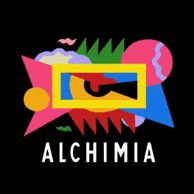Alchimia
design studio (1976)
Studio Alchimia is a post-radical avant-garde group founded in Milan in 1976 by Alessandro Guerriero and his sister Adriana Guerriero with the aim of "materializing something that does not exist", the first example of manufacturing designers.
Alchimia was not born as a temporary and isolated phenomenon in the creative context of the 1970s but as part of a broader cultural context, which began with the era of the Radical Movement in the mid 1960s and continued with Post Modernism.
Alchimia introduces the possibility for architects and designers to move and operate in different territories of creativity. The search for the new, free from production purposes, in the 70s and 80s. The pleasure of creating and discovering, of inventing the new as a pleasure for its own sake.
In the manifesto of the group it says: For the Alchimia group what counts today is the very act of “drawing”. Drawing, understood as an act of making signs, is not "drawing" or "designing": it is instead a free and continuous expression of thought, rendered visual. A “motivated” movement.
Studio Alchimia is an interdisciplinary and multifaceted group whose activities included seminars, experimental video production, clothing design, theatrical set design, product design, decorative arts, performance art and architecture.
Alchimia presents its first furniture collection at the "Bau.Haus uno" exhibition in 1978 which features works by Ettore Sottsass Jr., Alessandro Mendini, Andrea Branzi, Trix & Robert Haussmann, UFO, Michele De Lucchi and Paola Navone. Alchimia's 1980 exhibition "Bau.Haus due" included textile works by Daniela Puppa.
Among the main members of Studio Alchimia are the designers Alessandro Guerriero, Alessandro Mendini, Bruno Gregori, Giorgio Gregori, Arturo Reboldi, Pier Carlo Bontempi and Carla Ceccariglia.
The firm was organized by Adriana Guerriero-Reali, Tina Corti and Donatella Biffi. On the Alchimia Milano website you can find a list of all the people who have worked in or with Alchimia.
As a drawing group, Alchimia interprets its task as providing others with proof of "sentimental thinking". The motivation of the work does not lie in its practical effectiveness, the "beauty" of the object lies in the love and magic with which it is suggested in its soul.
Alchemy is not interested in disciplines when they are considered according to their own rules. It is more important to explore those large empty spaces between them.
For Alchimia, the hypothesis of the coexistence of confused design and production methods is valid, where craftsmanship, industry, IT, techniques and current and outdated materials can mix. " They are handcrafted, recycled, mass, improbable, provocative, kitsch objects, all very loaded with theory.
We work and experiment on many sectors: the Ideal Pension (Franco Raggi), the Covers of Domus (Occhiomagico), the Sound Suit and the performance of Painted People (Anna Gili), the Stylism of fashion (Cinzia Ruggeri). Neo-modern design is born, the new Italian design.
The Mobile Infinito in 1981 overturns both the typologies and the designers' signature, entering the theatrical experimentation with the Magazzini Criminali. The emotional, psychic and anthropological activities expand to books, teaching, videos (Metamorphosis) and sounds (Mathia Bazar).
In 1982 Alessandro Guerriero is a founding member of Domus Academy and in 1984 he starts a Nuova Alchimia with the Zabro brand. It is Aurelio Zanotta who favors this post-industrial collection.
In 1981 Studio Alchimia received the Compasso d'Oro award in the Design Studio category for design research.
In 1992 the romantic activity of Alchimia was concluded and thus his heroic adventure ended.





